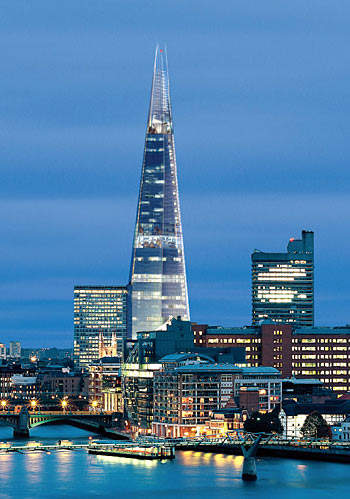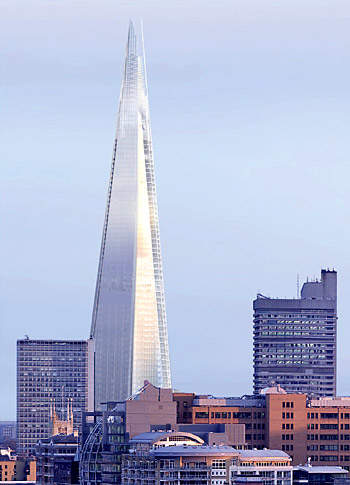The Shard London Bridge, previously known as London Bridge Tower, is a mixed-use building in London. Designed by Renzo Piano, the structure has been constructed on the site of an existing 1970s office building, known as Southwark Towers, adjacent to London Bridge station. It provides a mix of shopping, office, hotel, leisure and residential uses, as well as offering a variety of public spaces, including viewing galleries.
Central London has been the focal point for many prestigious developments in recent years, but, while the Swiss Re Tower development has taken its fair share of headlines, the south bank of the Thames is also attracting plenty of attention. Construction of the £2bn project began in March 2009, was completed in April 2012 and was officially opened on 5 July 2012.
The Greater London Authority (GLA) headquarters set the tone for flagship buildings south of the river, but the London Bridge Tower project may yet put it in the shade, dramatically altering the face of the south bank in the process.
After a public inquiry and almost three years of public consultation, the London Bridge Tower project finally got the go-ahead. In November 2003, the project received planning permission from the UK Government, and the wheels of change were set in motion for another striking addition to London’s skyline.
Shard London Bridge concept
The 72-storey Shard London Bridge, with an additional 15 roof radiator floors, is developed on the site of an existing 1970s office block bordering London Bridge station. It is a multi-use structure and the tallest of its kind in the European Union, standing 1,017ft tall. It incorporates around 602,779ft² of modern, high-spec office space, along with a 197-room hotel and a range of shopping, leisure, residential and public spaces.
The Sellar Property Group, which backed the project, believes it is London’s only truly mixed-use building, as nowhere else has such a blend of shops, office space, residential units, and leisure and visitor facilities. The site is easily capable of servicing such diverse needs, partly due to the existing train, bus and underground rail links.
Prior to construction, Foster and Partners’ Swiss Re Tower was receiving mixed reviews. However, since its completion in December 2003 Londoners have embraced it as an integral part of the city skyline. As the first green skyscraper, the Swiss Re Tower raised the bar for all future developments in the city.
Shard London Bridge has similar aspirations, and is judged according to these high standards.
Wealth of experience
Much of that success depended on the architect, Renzo Piano. Piano first came to prominence through his collaborations with Richard Rogers on high-profile projects such as the Centre Pompidou in Paris.
Now, almost 30 years after they went their separate ways, Piano’s firm, the Renzo Piano Building Workshop, is flourishing. Based in Genoa and Paris, it has worked on a number of major developments, such as the New York Times Building, as well as many civic projects.
A mixed blessing
Seen from the outside, the Shard London Bridge is a tapering, glazed spire dominating the surrounding area. Further east is the Tate Modern building, but in terms of height the only competition is over the bridge in the city.
The tower is made of granite, glass and steel. Its surface helps it blend in with the skyline by reflecting the sky and the surrounding buildings. Its shape and appearance, as much as its function, distinguishes it from many of the taller buildings across the river.
A vertical town
The design for the interior of the building caters to many different users. The huge office space and the sizeable residential space are intended to be versatile and high spec, providing leisure and retail opportunities for the general public as well as viewing decks for tourists.
The design for the tower was as much about building a community as constructing a viable commercial structure. The mixed-use facilities show that the building is one step ahead of its skyscraper counterparts elsewhere in London, in function as well as location. However, it also surpassed many of them in terms of visual impact.
A remodelled entrance to London Bridge station at the level of the station concourse leads out on to a public piazza, where there are cafes, restaurants, a health club and the much-vaunted Learning Centre. The idea for the Learning Centre grew from the recognition that Shard London Bridge is a focal point for the local community as much as the businesses renting its office space.
The developer has made premises available for a drop-in and training centre for those looking for work opportunities. The tower’s Business Centre could also figure in this effort, and incoming office tenants would be encouraged to participate in education schemes.
On the 26 floors above the piazza there are offices, followed by a three-storey public space at mid-level. This is designed to provide spectacular views of London as well as space for leisure activities, performances and exhibitions, and bars and restaurants.
The floors above, from 37 to 51, will house a five-star Shangri-La hotel with 197 rooms, which will be ready by early 2013. From the 52nd to the 63rd floor there are residential apartments, some occupying an entire floor in their own right. Again, most of the accommodation has superb views of London, with visibility of up to 30 miles on clear days. An open-air observation deck is located on the 72nd floor, while the spire is from floors 75-87.
Landmark for London
The final two floors of the building house a public viewing gallery, allowing visitors to enjoy a unique view of the city below. Above this, at the very pinnacle of the building, is the cooling radiator. There are 39 lifts in the tower, including 11 double-decker lifts for the office area. High-speed lifts move visitors rapidly up the outside of the building to the mid-level piazza and the top-level viewing gallery.
The designs for the public spaces have been developed with one eye on their anticipated patterns of usage. For instance, a key determinant of the model for the lower piazza is the fact that London Bridge station is a busy transport interchange with high levels of through-traffic. Electronic screens are installed so that commuters can see breaking news during rush hour, while ambient images are displayed at other times to create a more relaxing environment.
Related project
Heron Tower, United Kingdom
Heron Tower became the tallest building in the London, UK, when it reached its highest top out of 202m in April 2010. Located at 110 Bishopsgate, Heron Tower will become a new landmark and enhance the London city skyline.
Community
In creating a world-class address at London Bridge, the members of the design team have had to think very carefully about what they can offer the surrounding community beyond retail and business space. Many of the initiatives delivered infrastructure and facilities that benefitted the local community have centred on London Bridge station and the tower’s proximity to it.
The project enhanced the transport interchange at the station, providing a new bus station that services new routes. Pedestrian access to the rail and tube platforms was improved, and there were an extended taxi facilities and an enhanced cycle network.
The transformation of the station concourse was complemented by a significant amount of improvements at street level, particularly at St Thomas Street and Joiner Street. The building was designed to be a global attraction, bringing visitors to the area to see it and to use its viewing platforms. As such, it was expected to support its own commercial and leisure facilities as well as those in the surrounding area.
The tower itself required a significant management infrastructure, and this alone created over 300 jobs in engineering, administration and security. Much of this workforce could be sourced locally and trained during the construction period.
During the construction phase, contractors were required to appoint local people first, and positive discrimination towards the local workforce was encouraged. It was anticipated that in total, thanks in part to its development as a major tourist attraction, the tower helped create 1,000 new jobs locally, with local people ideally filling at least 50% of the positions.
Environmental impact
As with other major projects of recent times, both on the south bank and elsewhere in London, the environment has been key concern throughout the design stage. The new City Hall building, for instance, designed by Foster and Partners for the GLA, is a prime example of how energy-efficiency can be maximised through use of materials and innovative design.
The team behind the Shard London Bridge has also gone to great lengths to ensure that the structure is sensitive to the environment, on both a local and a global level. From a very early stage, strict targets were set for minimising the impact on the immediate environment and maximising energy efficiency.
In terms of local impact, the project is seen as paving the way for future investment in the surrounding area, which could potentially create a business development area that would support the long-term sustainability of such a flagship project.
Exceptional green credentials are also crucial. Shard London Bridge is the greenest building in London by reducing energy consumption by at least 30%.
In order to assess the environmental performance of the design, the plans were subject to a pre-assessment using the Building Research Establishment Environmental Assessment Method (BREEAM), which provided authoritative guidelines for minimising the adverse effects of buildings on global and local environments, and for promoting a healthy and comfortable indoor environment. The results of the investigation painted a very positive picture of the structure’s environmental impact.
The Shard London Bridge has cemented itself as a visually impressive addition to the London skyline, and will improve the city’s reputation for modern, environmentally aware and socially responsible buildings. It also helps to bring the wealth of the city south of the river and act as a benchmark for future mixed-use developments.
Contractors
The Sellar Property Group appointed its development team in 2004, bringing in Arup as design engineers, WSP Cantor Seinuk as civil and structural engineering design engineers and Davis Langdon & Everest as cost consultants.
GGR’s Unic spider crane was used for fitting glass panels of Shard’s exterior.
In July 2010, the Mace Group won the construction contract for the second phase of the project. The scope of the contract also included construction of a short tower, called London Bridge Place, built adjacent to the Shard London Bridge. The existing London Bridge House was replaced and the entire redevelopment was known as The London Bridge Quarter.







